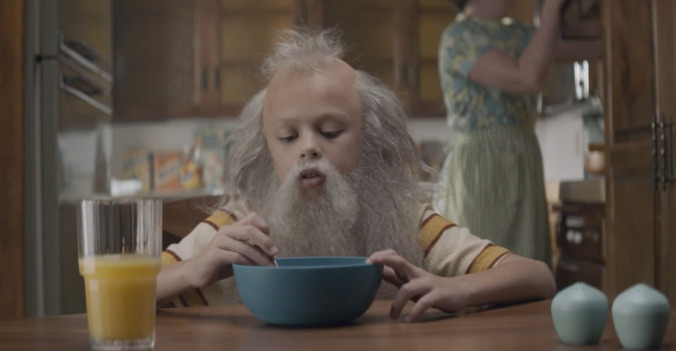Rick Rubin’s Shangri-La is a magical-yet-hokey monument to music—and to Rick Rubin


There’s a bit of cognitive dissonance in the not-exactly-a-Rick Rubin documentary Shangri-La, in that it deifies the music mogul while also deflecting credit for his genius onto some nonspecific higher power—the gods of creativity, if you will. Helping to discover, nurture, and create some of the most important music of the past 40 years was simply part of the path he traveled, the doc seems to say, as it follows him—almost always barefoot and wearing white—around the legendary studio space that he purchased and reinvented in 2011.
Don’t let the title fool you, though: This four-hour Showtime docu-series (exec-produced by Rubin, it should be noted) is more about the heavily bearded producer himself than the building, though he would surely argue that the two are inextricably linked in their ability to facilitate music. Shangri-La itself does have an incredible history that the doc touches on: It was a studio and gathering spot for some of the biggest stars of the 1970s, including Bob Dylan, Eric Clapton, and The Band. (Bits of Martin Scorsese’s The Last Waltz were filmed at Shangri-La, and they’re incorporated here.) Before that, it was home to a famous actress, served as a bordello, was used as an off-season stable for Mr. Ed, and may have housed a young guru—a fact that surely appealed to the wisdom-dropping Rubin.
On the other hand, Shangri-La doesn’t act like a typical documentary about a person, either. It spends a fair amount of time on Rubin’s well-trod college years, during which time he started Def Jam and inarguably became one of the most important people in hip-hop history, with legitimate contributions to the careers of Beastie Boys, Run-DMC, LL Cool J, Public Enemy, and many others. There are re-creations—complete with an actor portraying college-dorm-age Rubin—of that era, including a funny but unnecessary courtroom scene in which another student lodges a noise complaint. The Beastie Boys’ “(You Gotta) Fight For Your Right (To Party)” may have been inspired by it, the doc suggests.
But Shangri-La is far better when it grapples less with facts and more with the transcendent power of music. Rubin doesn’t seem to know exactly what he contributes to the albums that he produces, claiming repeatedly that he simply creates an environment in which creativity can flourish and mostly gets out of the way. (Rubin famously doesn’t actually work the mixing console, leaving that to a team of house engineers.) But he obviously has what the old-fashioned music business called “ears.” His prodigious talent is as a guidepost and sounding board.
And he sure knows a lot about music. The doc is packed with incredible conversations between Rubin and the musicians he’s worked with, shot lovingly in the austere confines of the white, white studio. Sunshine streams through the windows, with gorgeous, wildly wealthy Malibu just outside. At one point, his beard is mentioned, and the camera catches some kind of fairy dust falling from it. This is not an accident.
Rubin’s conversation with Chuck D about Public Enemy’s early days—Rubin basically talked Chuck into making a Public Enemy record rather than becoming a radio DJ—is the stuff of true fairy tales. Tyler The Creator offers another hip-hop perspective, in that he doesn’t have the history down, but he knows that Rubin has something that other producers don’t. Lil Yachty looks to him for advice, as do Rivers Cuomo, Mark Ronson, and countless others. Vampire Weekend’s Ezra Koenig worries aloud to Rubin whether his band’s upcoming album—the long-gestating Father Of The Bride—was sounding too “Shrek,” which as it turns out means too much like Smash Mouth. Rubin’s advice: Just let it be done, it sounds great, and six more months of tinkering isn’t going to make it better. Sometimes it’s the simplest advice, given from an experienced person, that means the most.
When Shangri-La tries to explain the magic of that incredible creativity, it sometimes stumbles. David Lynch, hardcore proponent of transcendental meditation, is great, but Sadhguru, an Indian yogi and mystic seen here in some killer Oakley sunglasses, doesn’t provide much beyond platitudes. Far worse, though, are Rubin’s conversations with “business philosopher” Seth Godin, who spends most of his time looking lovingly into Rubin’s eyes and agreeing with him. An actual quote from Godin: “When you were bringing hip-hop to the world, almost no one liked it. If you had needed everyone to like it, you would have burned out.” Translation: “You did this incredible thing even though you weren’t immediately embraced for it! You should be so proud of yourself!”
Rubin’s childhood is cheekily portrayed via reenactments with a kid made up to look like today’s Rubin, meaning he’s got flowing grey hair and a beard. Later eras are represented by a lifelike Rubin marionette. These vignettes are played remarkably straight, though, which conveys a deeper sense of humor and a bit more of a wink than the rest of the series does. Perhaps directors Morgan Neville (Won’t You Be My Neighbor?, 20 Feet From Stardom) and Jeff Malmberg (Marwencol) are acknowledging Rubin’s unsung sense of humor here—after all, the guy does unabashedly claim both professional wrestling and Buddhism as major influences.
But Rubin’s own, simpler philosophies make a kind of sense: He wants to “create space” for people to be creative and then to practice “the art of not being there.” Scenes of Shangri-La itself being judiciously cleaned and repainted are great: Everything is white, everything is spotless, there are no TVs or other distractions. Of course that’s a great place to be creative. And the few times that Rubin is shown being actively involved in a recording, it’s almost as a facilitating father figure: What if you sang that in falsetto? What if you added a few bars of bass there instead of more guitar? What if you just scrap this part altogether? It’s always gentle and wise, and frequently delivered by a man who’s literally laying down with his eyes closed. (That’s how he likes to work, and watching him do it, it’s hard to blame him.)
At nearly four hours, Shangri-La does occasionally feel overstuffed, and it can jump from navel-gazing philosophy to brass-tacks music history too abruptly. One scene with magician David Blaine and Rubin waxing goo-goo-eyed about the power of the mind would have sufficed, too. But there’s enough fascinating history in this place—and in the man—to make it worthwhile. It’s also beautiful to look at, painting its setting in a way that befits its name: a sun-dappled zone where magic is born. And Rubin, even when he sounds like a babbling New Age guru, is clearly someone who has made a connection with something higher via music. Pushing the idea that transcendence through art isn’t just possible, but reachable, is a noble goal. Pessimists might want to sit it out.